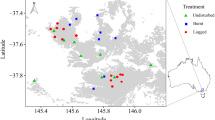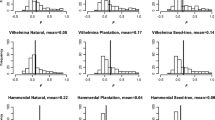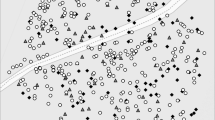Abstract.
Genetic diversity and mating system were quantified for shelterwood, patch cut and green tree-retention silvicultural systems, and compared to adjacent old-growth. This is a component of a larger study conducted in montane old-growth forests of coastal British Columbia to evaluate the feasibility and ecological consequences of alternative silvicultural systems. The experiment includes replicated treatments representing a range of overstory removal adjacent to old-growth and clearcut areas. Based on 22 electrophoretically assayed loci, the effects of silvicultural systems on genetic parameters of amabilis fir (Abies amabilis and western hemlock (Tsuga heterophylla were assessed by comparing an average number of alleles per locus, the percent polymorphic loci, and observed and expected heterozygosity between parental populations and naturally regenerated progeny as well as among treatments. Genetic variation in natural regeneration was greater than in parental populations, especially for low-frequency alleles. Silvicultural treatments caused no significant differences in amabilis fir genetic-diversity parameters, while the shelterwood system resulted in lower observed and expected heterozygosity in western hemlock. Nei's genetic distance revealed that all parental populations were extremely similar. The two species had contrasting mating system dynamics with amabilis fir producing higher levels of correlated paternity and inbreeding with wider variation among individual tree outcrossing-rate estimates. Western hemlock had significant levels of correlated paternity only for the green tree and shelterwood treatments demonstrating family structuring inversely related to stand density. Inbreeding in western hemlock was significant but lower than that observed for amabilis fir with a J-shaped distribution for individual tree multilocus outcrossing-rate estimates. The pollination and dispersal mechanisms of the two species represent the most-likely factors causing these differences. Artificial regeneration may be utilized to augment the genetic resources of natural ingress.




Similar content being viewed by others
References
Adams WT, Zuo J, Shimizu JY, Tappeiner JC (1998) Impact of alternative regeneration methods on genetic diversity in coastal Douglas-fir. For Sci 44:390–396
Aldrich PR, Hamrick JL (1998) Reproductive dominance of pasture trees in a fragmented forest mosaic. Science 281:103–105
Ally D, El-Kassaby YA, Ritland K (2000) Genetic diversity, differentiation and mating system in mountain hemlock (Tsuga mertensiana) across British Columbia. For Genet 7:97–108
Arnott JT, Beese WJ (1997) Alternatives to clearcutting in BC coastal montane forests. For Chron 73:670–678
Beese WJ (1995) Montane Alternative Silvicultural Systems (MASS) project establishment report. Land Use Planning Advisory Team, Corporate Forestry, MacMillan Bloedel Ltd, Nanaimo, British Columbia
Beese WJ, Arnott JT (1999) Montane alternative silvicultural systems (MASS): establishing and managing a multi-disciplinary, multi-partner research site. For Chron 75:412–416
Beese WJ, Bryant AA (1999) Effect of alternative silvicultural systems on vegetation and bird communities in coastal montane forests of British Columbia, Canada. For Ecol Management 115:231–242
Berg EE, Hamrick JL (1997) Quantification of genetic diversity at allozyme loci. Can J For Res 27:415–424
Buchert GP, Rajora OP, Hood JV (1997) Effects of harvesting on genetic diversity in old-growth eastern white pine in Ontario, Canada. Conserv Biol 11:747–758
Bush RM, Smouse PE (1992) Evidence of the adaptive significance of allozmes in forest trees. News For 6:179–196
Bush RM, Smouse PE, Ledig FT (1987) The fitness consequences of multiple-locus heterozygosity and growth rate in pitch pine (Pinus rigida Mill.). Evolution 41:787–798
Cheliak WM, Pitel JA (1984) Techniques for starch gel electrophoresis of enzymes from forest tree species. Petawawa Natl For Inst Info Rep PI-X-42:1–49
Clayoquot Scientific Panel (1995) Scientific panel for sustainable forest practices in Clayoquot Sound, report 5. Sustainable Ecosystem Management in Clayoquot Sound: Planning and Practices, Victoria, British Columbia
Clayton JW, Tretiak DN (1972) Amine-citrate buffers for pH control in starch-gel electrophoresis. J Fish Res Board Canada 29:1169–1172
Clegg MT (1980) Measuring plant mating systems. BioScience 30:814–818
Colangeli AM, Owens JN (1988) A phenological and cytological study of pollen development in western hemlock (Tsuga heterophylla). Can J Bot 66:907–914
Colangeli AM, Owens JN (1989) Postdormancy seed-cone development and the pollination mechanism in western hemlock (Tsuga heterophylla). Can J For Res 19:44–53
Colangeli AM, Owens JN (1990) Cone and seed development in a wind-pollinated, western hemlock (Tsuga heterophylla) clone bank. Can J For Res 20:1432–1437
Conkle MT, Hodgkiss PD, Nunnally LB, Hunter SC (1982) Starch gel electrophoresis of conifer seeds: a laboratory manual. USDA For Serv Gen Tech Rep PSW-64
Crawford PD, Oliver CD (1990) Abies amabilis Dougl. ex Forbes – Pacific silver fir. In: Burns RM, Honkala BH (tech coords). Silvics of North America, vol. 1, Conifers. USDA For Serv Agric Handbook 654, Washington DC, pp 17–25
Davidson R, El-Kassaby YA (1997) Genetic diversity and gene conservation of Pacific silver fir (Abies amabilis) on Vancouver Island, British Columbia. For Genet 4:85–98
Denti D, Schoen DJ (1988) Self-fertilization rates in white spruce: effect of pollen and seed production. J Hered 79:284–288
Edwards DGW (1976) Seed physiology and germination of western hemlock. In: Atkinson WA, Zasoski RJ (eds) Western hemlock management conference, May 1976. College For Res, University of Washington, Pullman, pp 87–102
El-Kassaby YA (2000) Impacts of industrial forestry on genetic diversity of temperate forest trees. In: Mátyás C (ed) Forest genetics and sustainability, vol 63. Kluwer Academic Publishers, The Netherlands, pp 155–169
El-Kassaby YA, Ritland K (1986) The relation of outcrossing and contamination to reproductive phenology and supplemental mass pollination in a Douglas-fir seed orchard. Silvae Genet 35:240–244
El-Kassaby YA, Sziklai O (1983) Effect of sample size on the precision of the estimate of allozyme frequencies in a natural stand of Douglas-fir. Egypt J Genet Cytol 12:345–360
El-Kassaby YA, Meagher MD, Parkinson J, Portlock FT (1987) Allozyme inheritance, heterozygosity and outcrossing rate among Pinus monticola near Ladysmith, British Columbia. Heredity 58:173–181
El-Kassaby YA, Ritland K, Fashler AMK, Devitt WJB (1988) The role of reproductive phenology upon the mating structure of a Douglas-fir seed orchard. Silvae Genet 37:76–82
Erickson VJ, Adams WT (1989) Mating success in a coastal Douglas-fir seed orchard as affected by distance and floral phenology. Can J For Res 19:1248–1255
Farris MA, Mitton JB (1984) Population density, outcrossing rate, and heterozygote superiority in ponderosa pine. Evolution 38:1151–1154
Fildes RA, Harris H (1966) Genetically determined variation of adenylate kinase in man. Nature 209:261–263
Forest Practices Code of British Columbia Act (1996) R.S.B.C. chapter 159
Franklin JF, Ritchie GA (1970) Phenology of cone and shoot development of noble fir and some associated true firs. For Sci 16:356–364
Furnier GR, Adams WT (1986) Mating system in natural populations of Jeffrey pine. Am J Bot 73:1022–1028
Green RN, Klinka K (1994) A field guide for site identification and interpretation for the Vancouver Forest Region. BC Min For, Land Manage Handbook No 28
Hosius B, Bergmann F, Konnert M, Henkel W (2000) A concept for seed orchards based on isoenzyme gene markers. For Ecol Management 131:143–152
Knowles P, Furnier GR, Aleksiuk MA, Perry DJ (1987) Significant levels of self-fertilization in natural populations of tamarack. Can J Bot 65:1087–1091
Koppenaal RS, Mitchell AK (1992) Regeneration of montane forests in the coastal western hemlock zone of British Columbia: a literature review. Pac For Centre, Can For Serv, Victoria, B.C., FRDA Rep 192
Lewis KG, El-Kassaby YA, Alfaro RI, Barnes S (2000) Population genetic structure of Pissodes strobi (Coleoptera: Curculionidae) in British Columbia, Canada. Ann Entomol Soc Am 93:807–818
Meagher TR (1986) Analysis of paternity within a natural population of Chamaelirium luteum. I. Identification of most-likely male parents. Am Natl 128:199–215
Mitton JB, Linhart YB, Hamrick JL, Beckman JS (1977) Observations on the genetic structure and mating system of Ponderosa pine in the Colorado Front Range. Theor Appl Genet 51:5–13
Mitton JB, Latta RG, Rehfeldt GE (1997) The pattern of inbreeding in Washoe pine and survival of inbred progeny under optimal environmental conditions. Silvae Genet 46:215–219
Morgante M, Vendramin GG, Rossi P (1991) Effects of stand density on outcrossing rate in two Norway spruce (Picea abies) populations. Can J Bot 69:2704–2708
Neale DB (1985) Genetic implications of shelterwood regeneration of Douglas-fir in southwest Oregon. For Sci 31:995–1005
Neale DB, Adams WT (1985) The mating system in natural and shelterwood stands of Douglas-fir. Theor Appl Genet 71:201–207
Nei M (1978) Estimation of average heterozygosity and genetic distance from a small number of individuals. Genetics 89:583–590
O'Malley DM, Wheeler NC, Guries RP (1980) A manual for starch-gel electrophoresis. Staff Paper Series, University of Wisconsin, Madison
Owens JN, Molder M (1977a) Vegetative bud development and cone differentiation in Abies amabilis. Can J Bot 55:992–1008
Owens JN, Molder M (1977b) Sexual reproduction of Abies amabilis. Can J Bot 55:2653–2667
Packee EE (1990) Tsuga heterophylla (Raf.) Sarg. – western hemlock. In: Burns RM, Honkala BH (tech coords). Silvics of North America, vol. 1, Conifers. USDA For Serv Agric Handbook 654, Washington DC., pp 613–622
Province of British Columbia (1995) Biodiversity guidebook. Co-published by BC Min For and BC Min Envir, Victoria, BC
Rajora OP (1999) Genetic biodiversity impacts of silvicultural practices and phenotypic selection in white spruce. Theor Appl Genet 99:954–961
Rajora OP, DeVerno L, Mosseler A, Innes DJ (1998) Genetic diversity and population structure of disjunct Newfoundland and central Ontario populations of eastern white pine (Pinus strobus). Can J Bot 76:500–508
Rajora OP, Rahman MH, Buchert GP, Dancik BP (2000) Microsatellite DNA analysis of genetic effects of harvesting in old-growth eastern white pine (Pinus strobus) in Ontario, Canada. Mol Ecol 9:330–348
Ridgeway GJ, Sherburne SW, Lewis RD (1970) Polymorphisms in the esterases of Atlantic herring. Trans Am Fish Soc 99:147–151
Ritland K (1989) Correlated matings in the partial selfer Mimulus guttatus. Evolution 43:848–859
Ritland K, El-Kassaby YA (1985) The nature of inbreeding in a seed orchard of Douglas-fir as shown by an efficient multilocus model. Theor Appl Genet 71:375–384
Schoen DJ, Stewart SC (1986) Variation in male reproductive investment and male reproductive success in white spruce. Evolution 40:1109–1120
Schoen DJ, Stewart SC (1987) Variation in male fertilities and pairwise mating probabilities in Picea glauca. Genetics 116:141–152
Siliciano MJ, Shaw CR (1976) Separation and visualization of enzymes on gels. In: Smith I (ed) Chromatographic and electrophoretic techniques, vol. II, 4th edn. William Heinemann Medical Books Ltd, London, UK, pp 185–209
Stoehr MU (2000) Seed production of western larch in seed-tree systems in the southern interior of British Columbia. For Ecol Management 130:7–15
Swofford DL, Selander RB, Black WC IV (1997) BIOSYS-2: a computer program for the analysis of allelic variation in genetics. http:\\wcb4.lamar.colostate.edu
Wright S (1965) The interpretation of population structure by F-statistics with special regard to systems of mating. Evolution 19:395–420
Zabinski C (1992) Isozyme variation in eastern hemlock. Can J For Res 22:1838–1842
Zheng T, Ennos R (1997) Changes in the mating systems of populations of Pinus caribaea Morelet var. caribaea under domestication. For Genet 4:209–215
Acknowledgements.
This study was funded by Forest Renewal British Columbia Grant number PA96570-RE. Shirley Barnes conducted all laboratory analyses and Clayton Chu the field collections.
Author information
Authors and Affiliations
Corresponding author
Additional information
Communicated by D.B. Neale
Rights and permissions
About this article
Cite this article
El-Kassaby, Y.A., Dunsworth, B.G. & Krakowski, J. Genetic evaluation of alternative silvicultural systems in coastal montane forests: western hemlock and amabilis fir. Theor Appl Genet 107, 598–610 (2003). https://doi.org/10.1007/s00122-003-1291-3
Received:
Accepted:
Published:
Issue Date:
DOI: https://doi.org/10.1007/s00122-003-1291-3




